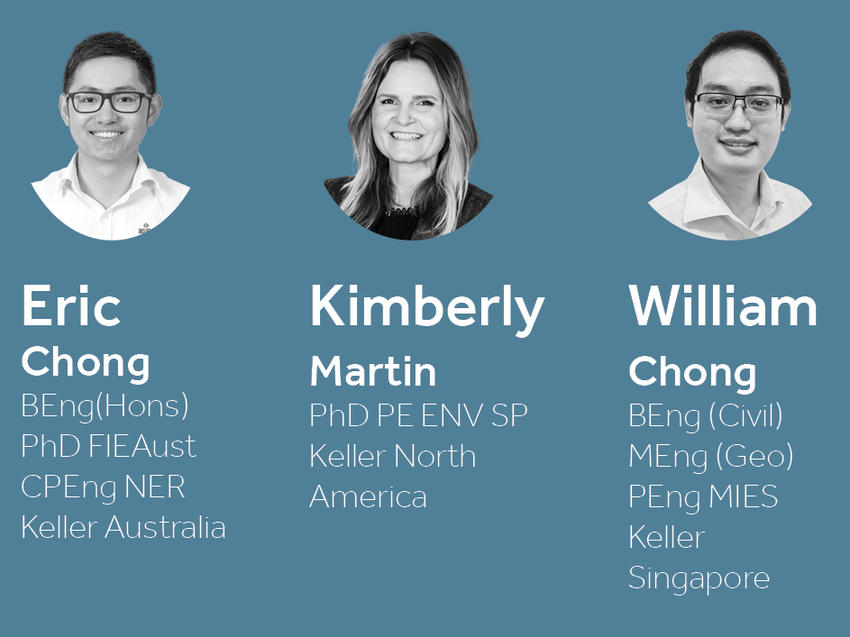Five papers, three presenters and two technical posters will all be presented by Keller and our work, at this year's conference.

Design and construction of the deepest CFA pile in Australia
W.L. Chong (Eric), BEng(Hons) PhD FIEAust CPEng NER, Keller, Melbourne, Victoria, Australia, +61395902600, eric.chong@keller.com.au
For a project located in Docklands Victoria, a high-rise development was proposed where the geology comprised soils of various compositions and consistencies to approximately 50m deep before being underlain by a siltstone bedrock. Due to the structural loads and spatial constraints, the majority of the foundation piles were designed to be socketed into the siltstone. Key factors in selecting the continuous flight auger (CFA) technique as an effective piling solution are explained. These factors included structural and geological considerations, piling rig capabilities, pile testing regime to verify load performance and integrity, the extensive suite of construction quality controls and instrumentation records required while also achieving an appropriate piling budget and program. This paper also described how these factors underpinned the design approach of the final piling scheme. Critical aspects considered during construction and post-construction quality and pile testing records required to meet and satisfy the strict project piling specifications are also presented. The project adopted what may be considered the “best practice” in deep CFA piling. To the author’s knowledge, this project achieved the record for the deepest CFA piles in Australia where multiple piles to 53.8m deep were constructed.
The geotechnical industry’s role in sustainable development
Kimberly Martin, Ph.D., P.E., ENV SP, Keller, North America, +1 602-454-0988, kimberly.martin@keller-na.com
Although the use of the term "sustainability" is becoming more widespread, it can be challenging to know what tangible things we can do as geotechnical engineers and contractors to further the goals of sustainable development. This talk will provide a brief background on sustainability, demonstrate how geotechnical engineers and contractors can significantly impact environmental sustainability, and provide ideas to push our industry forward on social sustainability. Also, case studies will be provided to show how the EFFC/DFI carbon calculator can be used to calculate the carbon footprint of a geotechnical foundation solution and how changes to the design and/or materials can reduce the environmental impact of that solution.
Innovative integrated jet grout and contiguous CFA piled solution for complex deep shoring wall in soft soils – retaining structural design and analysis
W.L. Chong (Eric), Keller, Melbourne, Victoria, Australia, +61395902600, eric.chong@keller.com.au
Y. Zou, Keller, Sydney, New South Wales, Australia, +61288661100, yong.zou@keller.com.au
There are many types of earth retention systems (ERS) available in the market where more than one method can be a feasible solution for a project. This paper examines the design and construct process of a project in Dee Why, NSW using a hybrid ERS comprising contiguous piles with jet grout infill. The development comprises a deep basement and mixed-use urban superstructure. The site is located in an area of variable ground conditions, high ground water table and in proximity to existing buildings with multi-level basements. This paper details a comprehensive assessment of the geological conditions and strategies adopted to better understand the effectiveness of the proposed product and to minimise the associated risks of the proposed solution. This involved conducting additional geotechnical investigation, extensive numerical modelling and in-situ monitoring of the movements and the performance of the walls. A monitoring regime consisting of inclinometers, survey points on capping beam and prisms on the neighbouring buildings and roads surrounding shoring wall was implemented. The monitoring results were back-analysed using computer software WALLAP, Plaxis–2D and Plaxis–3D for the post-construction examinations. This paper details the effectiveness and advantages of a hybrid ERS using contiguous piles with jet grout infill.
Comparison of large plate load test result with predicted deformation in deep vibro techniques treated ground for iron ore stockpile yard in Vietnam
William Chong Keller, Singapore, +65 6316 8500, william.chong@kellersing.com.sg
There are many types of Earth Retention Systems (ERS) available in the market where more than one method can be a feasible solution for a project. This paper examines the design and construct process of a project in Dee Why, NSW using a hybrid ERS comprising contiguous piles with jet grout infill. The development comprises a deep basement and mixed-use urban superstructure. The site is located in an area of variable ground conditions, high ground water table and in proximity to existing buildings with multi-level basements. This paper details a comprehensive assessment of the geological conditions and strategies adopted to better understand the effectiveness of the proposed product and to minimise the associated risks of the proposed solution. This involved conducting additional geotechnical investigation, extensive numerical modelling and in-situ monitoring of the movements and the performance of the walls. A monitoring regime consisting of inclinometers, survey points on capping beam and prisms on the neighbouring buildings and roads surrounding shoring wall was implemented. The monitoring results were back-analysed using computer software WALLAP, Plaxis–2D and Plaxis–3D for the post-construction examinations. This paper details the effectiveness and advantages of a hybrid ERS using contiguous piles with jet grout infill.
Technical posters
- Deep CFA piles application for foundation in Queensland
- Innovative integrated jet grout and contiguous CFA piled solution for complex deep soring wall in soft soils